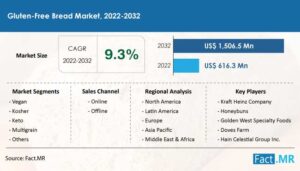Gluten-Free Bread Market In recent years, the culinary world has witnessed a remarkable transformation driven by evolving dietary preferences and health-conscious lifestyles. One of the most significant shifts has been the surge in demand for gluten-free products, with gluten-free bread leading the charge. This article delves into the burgeoning gluten-free bread market, exploring its origins, growth trajectory, and the factors propelling its popularity among consumers.
For More insights into the, Request a Sample of this Report:
Gluten-free bread, as the name suggests, is a type of bread that is crafted without the use of wheat, barley, rye, or other grains that contain gluten. Gluten is a protein that gives traditional bread its elasticity and structure. However, for individuals with celiac disease, gluten sensitivity, or those who simply opt for a gluten-free lifestyle, consuming products with gluten can lead to adverse health effects. Gluten-free bread emerged as a solution to cater to this expanding demographic.
Market Trends and Dynamics
- Health and Wellness Driving Demand: The gluten-free bread market owes much of its growth to the increasing focus on health and wellness. As more consumers become aware of dietary sensitivities and their impact on well-being, there is a heightened demand for products that align with specific health requirements. Gluten-free bread offers a way for individuals to enjoy a staple food while avoiding gluten-related complications.
- Diverse Ingredients and Flavors: Gone are the days when gluten-free products were associated with bland or limited options. Today, gluten-free bread comes in a multitude of flavors and varieties, thanks to innovative ingredient substitutions and baking techniques. Ancient grains like quinoa, millet, and sorghum, as well as legume-based flours, are often used to create texture and taste reminiscent of traditional bread.
- Innovation in Texture and Quality: One of the primary challenges in gluten-free baking is achieving a texture that closely resembles conventional bread. Manufacturers have invested in research and development to create gluten-free bread with a satisfying crumb, chewiness, and crust. Technological advancements and formulation improvements have led to significant strides in replicating the sensory experience of regular bread.
- Mainstream Availability and Accessibility: Gluten-free bread has transitioned from niche health stores to mainstream supermarket shelves. This increased accessibility has played a pivotal role in driving its market growth. Consumers no longer need to make special trips to specialized stores, making gluten-free options a convenient choice for a broader audience.
Growth Opportunities and Future Prospects
The gluten-free bread market presents a host of opportunities for both established players and newcomers looking to capitalize on changing consumer preferences.
- Nutritional Enrichment: Manufacturers can focus on enhancing the nutritional profile of gluten-free bread by incorporating functional ingredients such as seeds, nuts, and whole grains. Fortification with vitamins, minerals, and dietary fibers can further position gluten-free bread as a health-conscious choice.
- Clean Label and Transparency: As with other food products, consumers are increasingly interested in the origins of their gluten-free bread. Brands that prioritize transparency, clean labeling, and the use of wholesome ingredients can build trust and loyalty among discerning consumers.
- Artisanal and Gourmet Offerings: There is potential for artisanal and gourmet gluten-free bread to cater to consumers seeking premium and unique options. Crafting small-batch, high-quality bread with a focus on craftsmanship and distinctive flavors can elevate the gluten-free bread experience.
- Collaborations and Alliances: Collaboration between gluten-free bread producers and health experts, dietitians, or culinary influencers can provide valuable insights and guidance to consumers. Such partnerships can enhance consumer education and promote informed purchasing decisions.
In conclusion, the gluten-free bread market has evolved from a niche to a significant segment within the broader baking industry. With its emphasis on health, innovation, and accessibility, gluten-free bread has garnered widespread appeal among individuals seeking dietary alternatives. As consumer preferences continue to evolve and health-conscious lifestyles become more prominent, the gluten-free bread market is poised for sustained growth and is set to revolutionize the way we perceive and consume this dietary staple.
